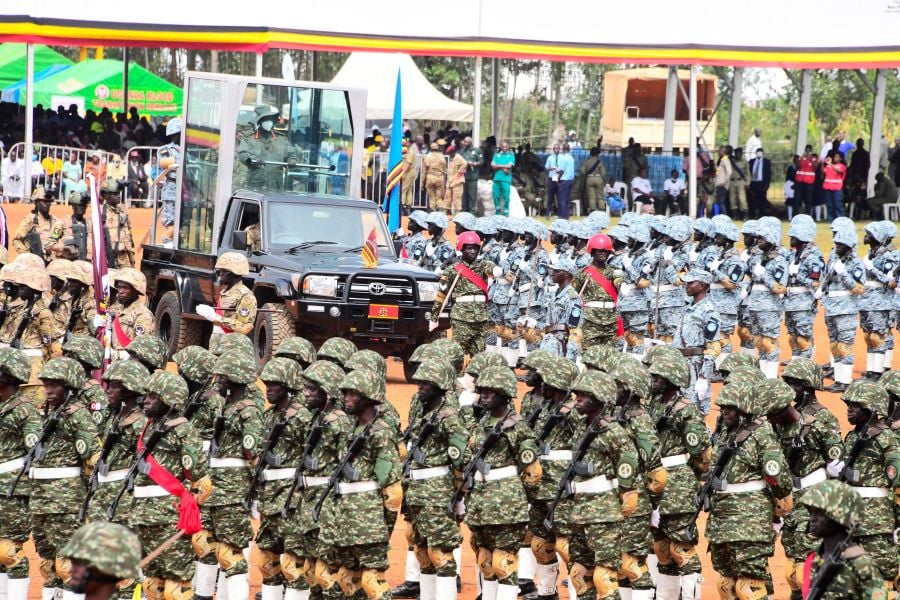President Yoweri Museveni, also the Commander-in-Chief of the Uganda People’s Defence Forces (UPDF), remains confident that Uganda’s economy will achieve double-digit growth once oil production begins. He estimates that by June 2025, the economy will grow by 7.3 percent without oil. Few nations attain such a rate. However, with oil production, growth is expected to surpass 10 percent.
Accompanied by First Lady and Minister of Education and Sports, Janet Museveni, the president shared these projections at the 44th Tarehe Sita Anniversary celebrations at Kasasa Township Grounds in Kyotera District. This year’s event ran under the theme Celebrating Pan-African Solidarity and People’s Sacrifice in the Struggle for Freedom and Democracy for Socio-Economic Transformation.
Observed annually on February 6, Tarehe Sita marks the founding of Uganda’s people’s army and commemorates the sacrifices made in the National Resistance Army (NRA) revolution.
Uganda’s Economic Growth: From 1986 to 2025
Museveni credited Uganda’s economic progress to five key developmental phases. Since 1986, the country has undergone several transformations. By June 2025, the economy is projected to reach $59.3 billion using the Foreign Exchange Method and $168.5 billion under the Purchasing Power Parity (PPP) method. This marks a significant rise from the $4 billion recorded in 1986.
The first phase focused on economic recovery by reviving coffee, cotton, and copper (3Cs) alongside tobacco, tea, and tourism (3Ts). These industries had collapsed under Idi Amin’s rule. The second phase expanded production, notably increasing coffee output from 2 million to 9 million bags. Economic diversification defined the third phase, while the fourth introduced value addition. In the current phase, Uganda is advancing into the knowledge economy, particularly in automobile manufacturing and vaccine production.
Museveni praised local scientists and innovators for their contributions to Uganda’s development, particularly in medical research and vaccine production. He acknowledged the progress in manufacturing essential diagnostic tools and the country’s self-sufficiency in sanitizer production.
Expanding Value Addition and Commercialization
The president encouraged Ugandans to embrace value addition in their industries to maximize economic gains. He pointed to Uganda’s advancements in coffee processing and reaffirmed the government’s commitment to expanding the economy to $500 billion in the coming years.
Greater Masaka has made significant strides in commercial coffee production, palm oil farming, and dairy processing. However, Museveni discouraged rice farming in flood plains, advocating for fishing in the Katonga region as a more suitable alternative.
National Stability and UPDF’s Role in Development
Museveni attributed Uganda’s lasting peace and stability to the founding principles of the NRA. He emphasized the nation’s commitment to strengthening state institutions, expanding education, modernizing infrastructure, and improving healthcare. Investments in electricity access, freedom of speech, and Pan-Africanism through regional integration further reinforced Uganda’s progress.
The president commended the people of Greater Masaka for their role in past liberation struggles. He acknowledged their contributions in 1972, 1979, and 1985-86, recognizing the region’s historic battles and unwavering support.
Museveni directed the Ministries of Works and Finance to maintain existing roads before launching new construction projects. He noted that while Uganda has seen extensive road development, planners neglected older roads, causing unnecessary deterioration. The Mutukula-Masaka road, for example, suffered from poor planning and required urgent rehabilitation. Moving forward, he insisted that infrastructure planning should prioritize older roads to avoid similar setbacks.
The president reassured Ugandans that UPDF remains capable of safeguarding both citizens and their property. He echoed Gen. Muhoozi Kainerugaba’s statement that the army stands ready to maintain national security.
Minister of Defence and Veteran Affairs, Jacob Oboth Oboth, emphasized collaboration between the political and military leadership to ensure lasting peace. He acknowledged Uganda’s improved military capability and urged citizens to protect the progress achieved over the years.
Gen. Muhoozi Kainerugaba reflected on the significance of Tarehe Sita, recognizing those who fought for Uganda’s freedom. He noted the event’s role in demonstrating Uganda’s progress and the vision guiding the country’s future.
Honoring the sacrifices of fallen fighters, he reiterated UPDF’s dedication to maintaining national security and stability. He expressed gratitude to President Museveni and all who supported the struggle for a liberated Uganda.
Tarehe Sita remains a symbol of resilience. Beyond celebrating the NRA’s victory, the event highlights Uganda’s ongoing transformation. UPDF continues to consolidate the gains of the liberation struggle by ensuring peace within Uganda and supporting regional stability in Africa.
At the ceremony, 41 individuals received medals for their outstanding contributions to Uganda’s liberation and development. These awards honored those who played key roles in shaping the country’s history and securing its future.
